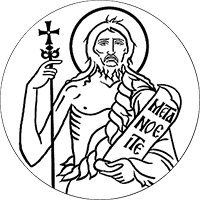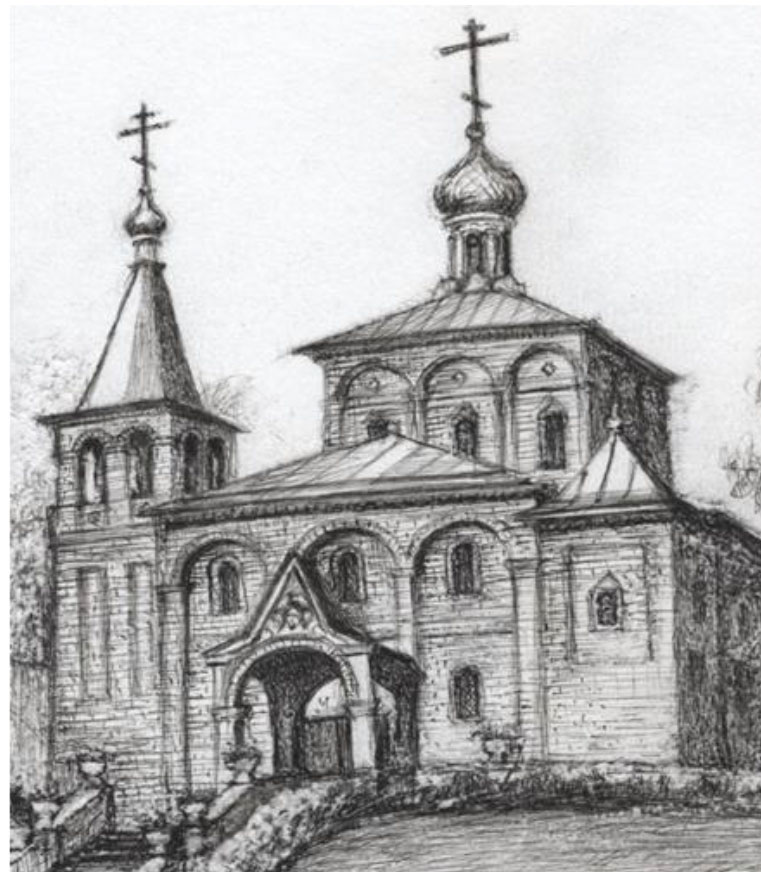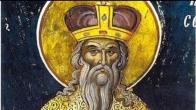You are here
St. Sophronius the Wonderworker, Bishop of Irkutsk and all Siberia
30 March / 12 April
 Stephen Kristalevsky was born in 1704 in the Chernigov Regiment, Little Russia [Ukraine], and baptized in honor of the Protomartyr Archdeacon Stephen. He had two brothers and one sister.
Stephen Kristalevsky was born in 1704 in the Chernigov Regiment, Little Russia [Ukraine], and baptized in honor of the Protomartyr Archdeacon Stephen. He had two brothers and one sister.
Stephen spent his early years in the little settlement of Berezan, in the Pereyaslavl region of Poltava Province. The family had settled there after his father was released from military service. Later, Stephen enrolled in the Kiev Theological Academy. At the time two others who were to become Holy Hierarchs - Joasaph, Bishop of Belgorod, and Paul, Metropolitan of Tobolsk, were at the Academy.
Upon completing his theological studies, Stephen entered the Holy Transfiguration Monastery in Krasnogorsk, where his older brother was already a monk. On April 23, 1730 Stephen was tonsured with the name Sophrony, in honor of Holy Hierarch St. Sophronios, Patriarch of Jerusalem.
On the night after he received monastic tonsure, Sophrony was in the Holy Protection Church, and heard a voice saying, “After you become a bishop, build a church dedicated to All Saints.” Thus it predicted his future service. Two years later, in 1732, he was summoned to Kiev, and in the St. Sophia Cathedral was ordained - first a hierodeacon, and then a hieromonk.
He served his obedience with the diocesan bishop of Pereyaslavl, and often would seek out solitude in his monastery, spending days in silent contemplation and labor, and presenting to the brethren an example of monastic activity.
Special notice was taken of Hieromonk Sophrony while he was at the Holy Synod on Episcopal business. In January 1742, when it became necessary to supplement the ranks at the Monastery of St. Alexander Nevsky in St. Petersburg, the future Holy Hierarch was among the 29 monks summoned for that purpose from various Russian monasteries. One year later he was appointed monastery treasurer, and in 1746 was appointed to be monastery administrator, an office he held for over seven years.
He summoned his countryman Hieromonk Sinesius, who was from Priluka, to assist him, and assigned him as builder of the New-Sergius Hermitage, a dependency of the St. Alexander Nevsky Monastery. From that time on, the friendship between the two spiritual strugglers, Hieromonk Sophrony and Hieromonk Sinesius, grew ever stronger in dedication to a single pastoral calling; they remained inseparable until their deaths in Siberia.
In 1747, Bishop Innokenty II (Nerunovitch) of Irkutsk reposed. For six years, Russia’s geographically largest diocese was left without spiritual nourishment. Finally, on St. Thomas Sunday, April 18, 1753, in the Great Dormition Cathedral, Hieromonk Sophrony was consecrated Bishop of Irkutsk and Nerchinsk.
Anticipating that his service in far-off Siberia would be difficult, the newly consecrated Holy Hierarch did not immediately go to the Irkutsk Diocese, but began to assemble educated and spiritually experienced co-workers. It was at this time that Holy Hierarch Sophrony visited his first monastery, in Krasnogorsk. He also visited Kiev’s holy sites, and asked the Saints of the Kiev-Caves to bless his service. As before, hieromonk Sinesius was his faithful traveling companion, and with zealous dedication shared in his difficult labors.
Bishop Platon of Moscow and Neva, who had taken part in Hieromonk Sophrony’s consecration, was of great help to him in Moscow. As he was well acquainted with the conditions of religious life in Siberia, he was able to give the Hierarch valuable pastoral advice with respect to his coming spiritual struggle; he warned him about the willful local authorities, and advised him to find reliable assistants.
On March 20, 1754, the Holy Hierarch arrived in Irkutsk. First, he went to the Ascension Monastery, residence of his predecessors, and prayed at the grave of Bishop Innokenty (Kulchitsky), asking his blessing to undertake his podvig.
After becoming acquainted with the state of affairs in the diocese, the Holy Hierarch began the work of transforming the Holy Consistory, the monasteries and parishes; he petitioned the Holy Synod to send him worthy people to take on the tasks of serving the Church in the Irkutsk Diocese.
By the time of Holy Hierarch Sophrony’s arrival, the monasteries of Irkutsk had already been in existence for almost a century. Their founders were filled with a burning desire for a life of monastic spiritual struggle. The perceptive Holy Hierarch chose pious, wise, active people with a wealth of religious and life experience to be abbots of the monasteries. In 1754, His Grace the Most-reverend Sophrony elevated his friend and co-struggler Hieromonk Sinesius to Archimandrite of the Ascension Monastery. This memorable rector served the monastery for thirty-three years, until his blessed repose. In September 1754, the Holy Hierarch issued a directive underscoring his concern for educating and rearing the children of clergy.
An attentive student of the people and the state of affairs, the Holy Hierarch tirelessly used homilies and private conversations to encourage everyone to strive toward higher moral standards. He paid special attention to seeing that the clergy perform the Divine Services and the Holy Mysteries piously and correctly. Likewise, he watched over the level of moral purity among the laity, showed concern about the position of women in the family, and guarded them from being treated unjustly.
Holy Hierarch Sophrony recognized that his calling to Apostolic service in that land required more than education of the faithful Christians; it also meant that he had to bring to the Faith the idol worshipers, of whom there was a great number in Siberia.
Bringing pagans to the Church of Christ was difficult, as there sometimes was nobody to serve in the churches, much less engage in missionary activities. Knowing what a good impression Hierarchical Service made on people of other faiths, the Holy Hierarch not only himself served piously, but also demanded the same of all his clergy.
Holy Hierarch Sophrony made efforts to put in good order the life of minority ethnic groups, and he facilitated the development of a flourishing, settled, way of life and culture among the local populace; he offered them the opportunity to settle on monastic land, and in every way possible strove to keep them away from pagan influences. A multitude of visitors, in a constant stream from near and far, would come to receive the Holy Hierarch’s blessing.
However, amid his many cares, he did not neglect his inner, spiritual life and eternity; he lived a life of spiritual struggle.
His spirit of struggle comported to the general uplifting of Christian spirit experienced in Russia after the glorification of Holy Hierarch Dimitry of Rostov and Theodosiy of Chernigov, and especially after the finding of the incorrupt relics of his predecessor, Holy Hierarch Innokenty of Irkutsk. That event greatly strengthened Holy Hierarch Sophrony and instilled in him the hope that Holy Hierarch Innokenty would assist him in the work of managing the Diocese.
Sensing that his health was worsening, Holy Hierarch Sophrony requested that the Synod grant him retirement. However, a response was slow to come from St. Petersburg, as it was difficult to immediately find a worthy successor.
Holy Hierarch Sophrony spent his final days in prayerful struggle.
To this day, the light that shone forth in St. Sophrony’s good works continues to bear witness to the glory of our Heavenly Father, “Who mercifully strengthens His saints.” And now the holy memory of Holy Hierarch Sophrony is reverently treasured not only in Siberia, where carried on his final spiritual struggles, but also in the place where he first took on those struggles.
PARISH LIFE
RECENT VIDEOS
Address of our Cathedral
Subscribe to our mailing list
While all the materials on this site are copyrighted, you may use them freely as long as you treat them
with respect and provide attribution on the Russian Orthodox Cathedral of St.John the Baptist of Washington DC.









